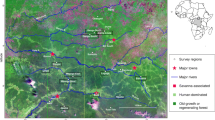Abstract
Descriptions of new tool-use events are important for understanding how ecological context may drive the evolution of tool use among primate traditions. Here, we report a possible case of the first record of tool use by wild Amazonian capuchin monkeys (Sapajus macrocephalus). The record was made by a camera trap, while we were monitoring caiman nest predation at Mamirauá Reserve in Central Amazonia. An adult individual was registered in a bipedal posture, apparently using a branch as a shovel to dig eggs out of a nest. Caiman eggs are frequently depredated by opportunistic animals, such as the capuchin monkeys. As the Mamirauá Reserve is covered by a high-productivity forest, and caiman eggs are a high-quality food resource seasonally available on the ground, we believe that tool use by capuchins is more likely to be opportunity driven, rather than necessity driven, in our study site.

Similar content being viewed by others
References
Alfaro JWL, Boubli JP, Olson LE et al (2012) Explosive Pleistocene range expansion leads to widespread Amazonian sympatry between robust and gracile capuchin monkeys. J Biogeogr 39:272–288
Barão-Nóbrega JAL, Marioni B, Villamarín F et al (2014) Researcher disturbance has minimal impact on natural predation of caiman nests in central Amazonia. J Herpetol 48:338–342
Bentley-Condit V, Smith EO (2010) Animal tool use: current definitions and an updated comprehensive catalog. Behav 147:185–221
Da Silveira R, Ramalho EE, Thorbjarnarson JB, Magnusson WE (2010) Depredation by jaguars on caimans and importance of reptiles in the diet of jaguar. J Herpetol 44:418–424
de Moura ACA, Lee PC (2004) Capuchin stone tool use in caatinga dry forest. Science 306:1909
Fragaszy DM, Visalberghi E, Fedigan L (2004) The complete capuchin: the biology of the genus Cebus. Cambridge University Press, Cambridge
IDSM (2010) Plano de gestão reserva de desenvolvimento sustentável mamirauá RDSM. MCTI/IDSM-OS, Tefé
Koops K, Visalberghi E, Van Schaik CP (2014) The ecology of primate material culture. Biol Lett 10:1–4
Lang JW (1987) Crocodilian behavior: implications for management. In: Webb GJW, Manolis SC, Whitehead PJ (eds) Wildlife management: crocodiles and alligator. Surrey Beatty, Chipping Norton, pp 273–294
Ottoni EB, Izar P (2008) Capuchin monkey tool use: overview and implications. Evolut Anthropol 17:171–178
Peres CA (1997) Primate community structure at twenty western Amazonian flooded and unflooded forests. J Trop Ecol 13:381–405
Prance GT (1979) Notes on the vegetation of Amazonia. III. The terminology of Amazonian forest types subject to inundation. Brittonia 31:26–38
Ramalho EE, Macedo J, Vieira T et al (2009) Ciclo hidrológico nos ambientes de várzea da Reserva de Desenvolvimento Sustentável Mamirauá—médio rio Solimões, período de 1990 a 2008. Uakari 5:61–87
Rueda-Almonacid JV, Carr JL, Mittermeier RA et al (2007) Las tortugas y los cocodrilianos de los países andinos del trópico. Panamericana, Bogotá
Shumaker RW, Walkup KR, Beck BB (2011) Animal tool behaviour: the use and manufacture of tools by animals. John Hopkins University Press, Baltimore
Souto A, Bione CBC, Bastos M et al (2011) Critically endangered blonde capuchins fish for termites and use new techniques to accomplish the task. Biol Lett 7:532–535
Spagnoletti N, Visalberghi E, Verderane MP et al (2012) Stone tool use in wild bearded capuchin monkeys, Cebus libidinosus. Is it a strategy to overcome food scarcity? Anim Behav 83:1285–1294
Villamarín F, Botero-Arias R, Thorbjarnarson J, et al (2008) Hatching success of black caiman (Melanosuchus niger) nests and spatial relations on egg collection by humans in the Mamirauá Sustainable Development Reserve, Brazil. In: Crocodiles. Proceedings of the 19th Working Meeting of the Crocodile Specialist Group of the Species Survival Comission of IUCN—the World Conservation Union convened at Santa Cruz de la Sierra. IUCN/SSC Crocodile Specialist Group, Santa Cruz de la Sierra, pp 333–340
Villamarín F, Marioni B, Thorbjarnarson JB et al (2011) Conservation and management implications of nest-site selection of the sympatric crocodilians Melanosuchus niger and Caiman crocodilus in Central Amazonia, Brazil. Biol Conserv 144:913–919
Visalberghi E, Fragaszy DM (2013) The Etho-Cebus Project: stone-tool use by wild capuchin monkeys. In: Sanz CM, Call J, Boesch C (eds) Tool use in animals: cognition and ecology. Cambridge University Press, New York, pp 203–222
Acknowledgements
This research was funded by the Instituto de Desenvolvimento Sustentável Mamirauá (IDSM-OS/MCTI) and by the IDSM AQUAVERT project funded by the Programa Petrobras Ambiental. The caiman-nest monitoring is a project of the Caiman Conservation and Management Research Program of IDSM. We thank the Infrastructure and Logistics Team at Mamirauá Institute for supporting our fieldwork. Vanessa Schmitt, Erenilson de Oliveira, Hidelbrando Silva, Ozimar Silva, Erivan Castro, João Carvalho and Helson Pinto Martins assisted with the fieldwork. We also thank Patrícia Izar for her valuable suggestions regarding an early draft of the manuscript, Bill Magnusson for the final English review, the editor and one anonymous reviewer for their contributions that improved the manuscript.
Author information
Authors and Affiliations
Corresponding author
About this article
Cite this article
Torralvo, K., Rabelo, R.M., Andrade, A. et al. Tool use by Amazonian capuchin monkeys during predation on caiman nests in a high-productivity forest. Primates 58, 279–283 (2017). https://doi.org/10.1007/s10329-017-0603-1
Received:
Accepted:
Published:
Issue Date:
DOI: https://doi.org/10.1007/s10329-017-0603-1




